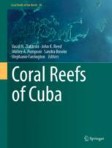Search
Search Results
-
The scleractinian Agaricia undata as a new host for the coral-gall crab Opecarcinus hypostegus at Bonaire, southern Caribbean
The Caribbean scleractinian reef coral Agaricia undata (Agariciidae) is recorded for the first time as a host of the coral-gall crab Opecarcinus...

-
Population connectivity among shallow and mesophotic Montastraea cavernosa corals in the Gulf of Mexico identifies potential for refugia
Successful management of spatially isolated coral reefs is contingent on an understanding of ecological connections across populations. To...

-
Outline of the Geology, Geomorphology, and Evolution of the Late Quaternary Shelf and Uplifted Marine Terraces of Cuba: Tectonic and Sea-Level Control of Present-Day Coral Reef Distribution
Cuba, similar to other islands in the Greater Antilles (Hispaniola, Puerto Rico, Jamaica), has an extensive and morphologically complex coastal,...
-
High diversity, abundance and distinct fish assemblages on submerged coral reef pinnacles compared to shallow emergent reefs
Coral reefs exhibit consistent patterns in biodiversity across multiple spatial scales, from local to global clines in species richness, abundance...

-
Local human impacts disrupt depth-dependent zonation of tropical reef fish communities
The influence of depth and associated gradients in light, nutrients and plankton on the ecological organization of tropical reef communities was...

-
Insights from Cuban Coral Reefs
In the 1970s, the Cuban coral reefs were the object of extensive exploration. The results were published in Spanish, Russian, French, and German but...
-
Distribution and ecology of shallow-water black corals across a depth gradient on Galápagos rocky reefs
Antipathes galapagensis is a prevalent habitat-forming black coral in subtidal ecosystems of the Galápagos Marine Reserve (GMR). Despite their...

-
Phylogeny and biogeography of the algal DMS-releasing enzyme in the global ocean
Phytoplankton produce the volatile dimethyl sulfide (DMS), an important infochemical mediating microbial interactions, which is also emitted to the...

-
A Study of Sponge Symbionts from Different Light Habitats
The amount of available light plays a key role in the growth and development of microbial communities. In the present study, we tested to what extent...

-
The Modern Times
Scleractinian reefs developed over the Quaternary era–the last 2.8 million years–are regarded herein as modern. First, are presented the main...
-
The Long March of Corals
After providing a brief history of the emergence of Life on the early Earth and of the chemical evolution of the atmosphere and the early ocean,...
-
New Negombata species discovered: latrunculin mystery solved
The Red Sea features a remarkable diversity of marine natural products. Among its coral-reef residents, sponges (phylum Porifera) are recognized as a...

-
A review of a decade of lessons from one of the world’s largest MPAs: conservation gains and key challenges
Given the recent trend towards establishing very large marine protected areas (MPAs) and the high potential of these to contribute to global...

-
Breviolum and Cladocopium Are Dominant Among Symbiodiniaceae of the Coral Holobiont Madracis decactis
The scleractinian reef building coral Madracis decactis is a cosmopolitan species. Understanding host–symbiont associations is critical for assessing...

-
Conspicuous endolithic algal associations in a mesophotic reef-building coral
Understanding how corals and their symbionts specialize across depth gradients allows us to understand biodiversity in shallow and mesophotic coral...

-
Concise review of the kelp genus Eisenia Areschoug
Eisenia (order Laminariales) is a genus of warm-tolerant kelps found in the Northern and Southern Hemispheres of the East Pacific, as well as in the...

-
Depth-related patterns in coral recruitment across a shallow to mesophotic gradient
There is currently very limited information around the spatial patterns of coral recruitment at mesophotic depths globally. This study investigated...

-
Marginal Reefs in the Anthropocene: They Are Not Noah’s Ark
In this book chapter, we review and discuss the resistance of marginal reefs and their potential as refugia. Marginal reefs (MRs) greatly differ from...
-
Evidence of photoacclimatization at mesophotic depths in the coral-Symbiodinium symbiosis at Flower Garden Banks National Marine Sanctuary and McGrail Bank
Similar to shallower conspecifics, mesophotic scleractinian corals found at ~ 30–150 m depths maintain important symbioses with photosynthetic...

-
The Bahamas and Cayman Islands
As shallow coral reefs worldwide are increasingly degraded by natural and anthropogenic stressors, mesophotic coral ecosystems (MCEs; ~30–150 m)...
